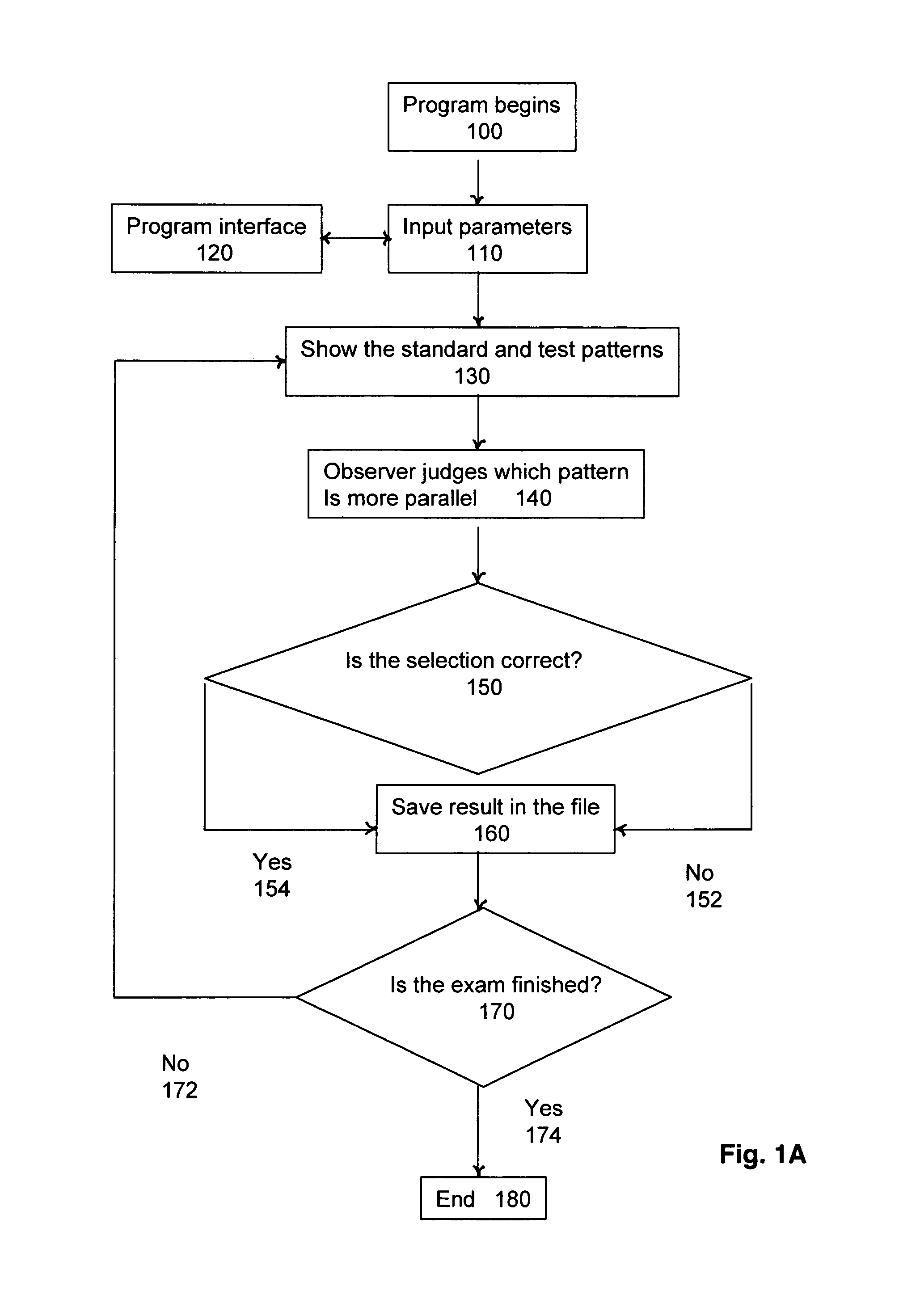System and method for detecting central retinal distortions associated with macular diseases
- Summary
- Abstract
- Description
- Claims
- Application Information
AI Technical Summary
Benefits of technology
Problems solved by technology
Method used
Image
Examples
example 1
Discrimination of Orientation Variability in Short Line Segments by Normal Observers
[0056]Groups of randomly positioned short parallel lines frequently appear to observers with normal vision to vary in orientation. In subjects with early AMD, the added orientation variability produced by disruption of the photoreceptor layer would be expected to make the discrimination between parallel and non-parallel groups of lines more difficult. Discrimination between flashed parallel and non-parallel line segments in normal observers can be quantified.
[0057]In each trial, two groups of bright line segments were flashed sequentially within a 1 deg by 1 deg area on a dark background (FIG. 2A-2D). All of the lines in one group were parallel. In the other group, the orientation of each line in the group varied randomly from the mean orientation, e.g., horizontal, according to a pre-determined angular standard deviation (SD). Each group of lines was flashed for 200 ms to prevent scanning eye moveme...
example 2
Orientation Discrimination for Randomly Positioned Line Segments in Subjects at-Risk for Developing or Having Early AMD
[0060]17 eyes of 11 subjects with healthy maculae and 25 eyes of 15 subjects at-risk for early AMD were tested. At-risk eyes were identified by the presence of macular drusen and / or early RPE changes, as determined from digital fundus photographs by a masked examiner. Normal subjects varied in age from 52-79 (median=65 years) and at-risk subjects varied in age from 58-82 (median=69 years). Best-corrected visual acuity ranged from 20 / 15-20 / 30 (median=20 / 20) in the normal subjects and from 20 / 15-20 / 40+1 (median=20 / 20) in the at-risk group.
[0061]To assess orientation discrimination, subjects viewed two 1-deg patches that contained 0.4-deg lines (FIGS. 2A-2D). Each pair of patches was presented for 200 ms and straddled a fixation spot along one of 4 meridians. In one randomly selected patch the lines were parallel and in the other patch the orientation of each line vari...
example 3
Discrimination of Orientation Variability in Short Line Segments by Observers Having Exudative AMD
[0063]Participants are beginning intravitreal anti-VEGF injections. e.g., bevacizumab or ranubizimab, to treat macular fluid that results from choroidal neovascularization. The test of orientation discrimination uses the following protocols differing from those in Example 2. First, sets of parallel and non-parallel line segments are presented sequentially (FIGS. 4A-4B). Second, the length of the randomly positioned line segments is 0.6 deg and the number of line segments in each presentation is 10. Third, each presentation is centered within the same 4-deg central region of the field, rather than offset along different visual-field meridians. Fourth, fixation is directed between a set of 4 peripherally located brackets. Fifth, the total number of trials per eye is approximately 20 and an adaptive psychophysical method is used (12-13).
[0064]Within one trial, each set of lines is presente...
PUM
 Login to View More
Login to View More Abstract
Description
Claims
Application Information
 Login to View More
Login to View More - R&D
- Intellectual Property
- Life Sciences
- Materials
- Tech Scout
- Unparalleled Data Quality
- Higher Quality Content
- 60% Fewer Hallucinations
Browse by: Latest US Patents, China's latest patents, Technical Efficacy Thesaurus, Application Domain, Technology Topic, Popular Technical Reports.
© 2025 PatSnap. All rights reserved.Legal|Privacy policy|Modern Slavery Act Transparency Statement|Sitemap|About US| Contact US: help@patsnap.com



